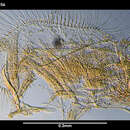en
names in breadcrumbs


"TYPE-SPECIES—Anarthron dithrix, described herein.
ETYMOLOGY—The generic name "Anarthron" is derived from the Greek "an" [= not, without] and "arthron" [= joint] in reference to the absence of numerous distinct joints on the rod-shaped organ. Gender: neuter.
This new genus contains five species: A. reticulate (Hartmann, 1965); A. chilensis (Hartmann, 1965); A. pholion, new species; A. dithrix, new species, and A. evexum, new species. The new genus appears to belong between Scleroconcha and Philomedes—the shell resembles the former genus and the rod-shaped organ the latter.
DIAGNOSIS—Carapace of female with 3 or 4 horizontal ridges; ridges stout on A. chilensis, A. evexum, and A. dithrix but weak on A. reticulate and A. pholion. Infold of rostrum with row of 7 to 11 bristles and several shorter bristles near outer edge; anteroventral infold striate and with about 15 short spinous bristles; infold of caudal process with short ridge bearing 1 bristle, and 2nd bristle near posterior edge of process; list of posteroventral and posterior infold with numerous small bristles forming groups with 1 to 6 bristles. Carapace of male with ridges subdued or absent.
First and second antenna, maxilla, mandible, fifth and sixth limbs: Similar to those of Scleroconcha.
Seventh limb: Limb of female with 4 proximal and 6 distal bristles; tip of limb opposite comb bare on known species; male with 4 or 5 proximal and 6 distal bristles.
Furca: Each lamella with 9 to 13 claws; A. reticulata with 4 stout claws followed by 8 or 9 shorter and weaker claws on female and 6 or 7 on male; remaining species, A. chilensis, A. dithrix, A. pholion, A. evexum, with 3 stout claws followed by 6 to 10 shorter and weaker claws. On A. reticulata, 3rd claw slightly more slender than 4th.
Lateral eye: Females with small lateral eyes with 2 or 3 ommatidia. Males with well-developed lateral eyes with 18-20 ommatidia.
Medial eye and rod-shaped organ: Medial eye similar to that on Scleroconcha. Rod-shaped organ elongate with crinkles or 2 sutures near middle; some species with additional faint incipient sutures; tip of organ rounded or tapering to fine point.
DISTRIBUTION—In the study area this genus was collected along the Atlantic and Pacific coasts of South America and in the Drake Passage. Its depth range is from 71 to 1173 m." (Kornicker 1975, p.340-341)